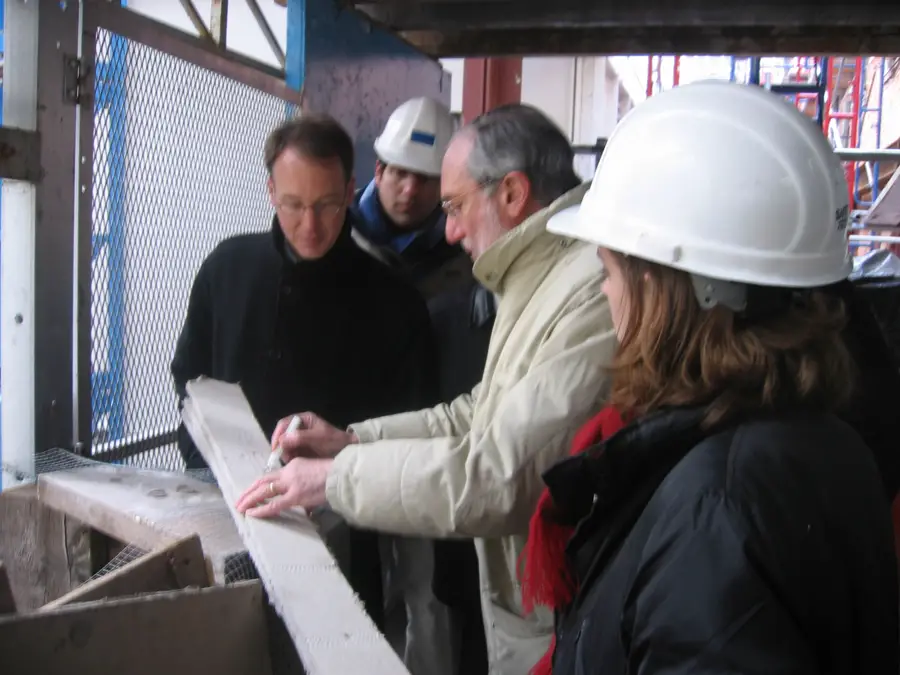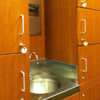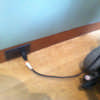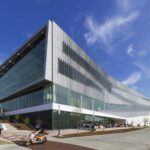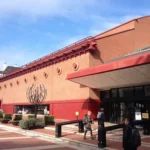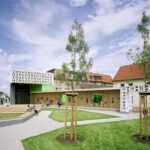Disability Access Design Issues, Mobility, Renzo Piano Building New York, Architects
Morgan Library and Museum Access
Library and Museum in New York City – article by Joel Solkoff, Aug 24, 2013
What I want from my readers?
Entrance to the Vault of the Morgan Library and Museum, the central theme of Piano’s Morgan Expansion described below.
27 Nov 2013 + 15 Oct 2013 + 1 Oct 2013 + 24 Aug 2013
Disability Architecture
Morgan Library:
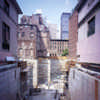
photo © Renzo Piano Building Workshop. Courtesy Gagosian Gallery
When I began this column on February 17, 2013, I wrote: “The future of architecture is rapidly requiring you to redesign the world to meet the requirements of the largest generation in world history. Ours is an aging population in the process of developing disabilities–but a generation with the determination, education, political clout, and for many the wealth to live independently none-the-less.”
Renzo Piano and Joseph Mizzi, President of the Sciame Construction, on site at the Morgan:
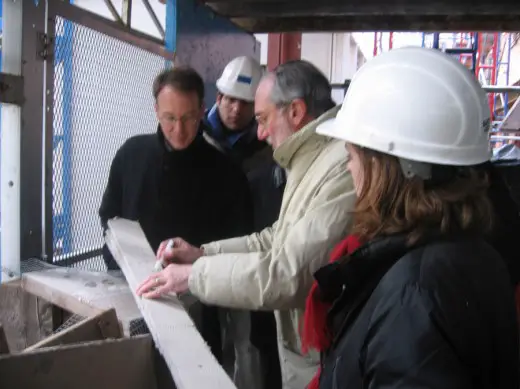
permission to use : Sciame Construction
*******************
Giorgio Bianchi, one of the most experienced architects from the Renzo Piano Building Workshop, in discussion with Joel Solkoff, a research assistant at the Department of Architectural Engineering at Penn State, USA, campaigner for good access for disabled and elderly in buildings and regular e-architect guest editor.
Part 2 of 3: Giorgio Bianchi
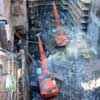
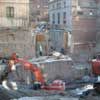
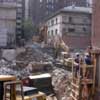
photos by permission of Robert Silman Structural Engineering, New York, New York
Part 1 of 3: Giorgio Bianchi interview
Giorgio Bianchi is interviewed about his role in executing Renzo Piano’s J.P. Morgan Library and Museum Building, New York City, USA – his Creative Vision of the Vault ; how he went about the job of executing Renzo Piano’s vision ; his perspective on the role of the executive architect namely Bender Beyer Belle in clearing away the incredible regulatory hurdles ; his views on Building Information Modeling and the use of Revit to create BIM-compliant virtual reality models.
*******************
Suddenly, out of the blue, a wild and crazy ride took place. In April, I was diagnosed with kidney cancer, told by my physician that I could not be treated in this area because of the absence of appropriate expertise. She referred me to Memorial Sloan Kettering Cancer Center in New York City, a complex of buildings on the Upper East Side of Manhattan—not far from where Gucci sells Gucci’s. Sloan Kettering is the best health care facility I have experienced in my many years as someone who goes to hospitals a lot—each time, of course, photographing the disability features and lack of them.
After several trips to New York, at which I took a large number of disability-related photographs, a world specialist Dr. Paul Russo removed a cancerous tumor from my right side (which still aches, but not as much as before). He saved my kidney and he saved my life.
Meanwhile, of course, a serendipitous event took place. Now, is a good time to take a break from the previous train of thought. Let me here digress with thoughts about who my readers are and the desire to hear from you.
Let me tell you whom I am writing for. I am writing for architects aged 26-35. I am writing for talented young architects working in an important architecture firm. These are architects whose talent has already been recognized and they are on the ladder to being partner. I am not addressing this column to partners because they are too busy to understand my perspective and incorporate it. My perspective is that disability access is a requirement for doing business as U.S. citizens retire at the rate of 10,000 a day for 20 years.
My perspective is that the sky is falling for architects. The demand for appropriate housing and health care facilities will dominate the attention of the vast bulk of the architecture community. What I want to do is show you the built world from my perspective as a paraplegic. I want you to see what I see. If I can influence you before you make partner, your instincts will be right on on this subject.
The music auditorium which is Renzo Piano’s greatest disability achievement. Hitherto, the Morgan has been a Library housing beautiful musical manuscripts. Now with the construction of the auditorium, the manuscripts themselves can be used for performance. This opens up the Collection to the blind—certainly, a blessed achievement:
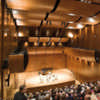
photo © Renzo Piano Building Workshop. Courtesy Gagosian Gallery
To return to the word serendipity. It means: “The faculty of finding valuable or agreeable things not sought for.”
When I use serendipity within the context of recent Disability Architecture columns, I am referring to my writing about The Morgan Museum and Library and Renzo Piano’s role in the renovation, his first commission in New York City—a City he now owns after construction of the dazzling New York Times building (by the way the metallic skirt-like device surrounding the building was sufficiently low that individuals were jumping onto and off the building; this happened with sufficient frequency a smaller metal skirt had to be developed).
Piano is a fascinating figure for reasons I cannot yet explain. My trip to the Morgan took place in April, the day before my first meeting with my surgeon. At the Morgan, I fell in love with a manuscript by Mozart. A friend had suggested we meet at Piano’s New Morgan, as she put it. As it so happens, I had remembered my frequent visits to the Morgan Library in 1971, then an old fuddy duddy Beaux Arts structure where the illuminated manuscripts took my breath away.
Years later: Not only did I find the Mozart wonderful, I felt similarly about the architecture. It took my breath away. It took my breath away. (I had promised you an analysis of the individual disability accommodations on which I will deliver.)
++++
It is time now to return to my readers. I want to know how I can communicate with you better. My inclination as a writer is to write and write and write. Last month I published the longest article in e-architect history and my editor Adrian Welch won’t put up with that. These columns need to be smaller and better focused. The problem is that sometimes the details I accumulate in such quantify are useful. My experience with Renzo Piano is that I was able to understand the details of his Creative Design, which is brilliant.
The photograph above displays Piano’s love for craftsmanship. The photo shows the wash basin area at the special reading room for qualified scholars.
By contrast, below is an example of too few electrical outlets at the beautiful Atrium where there is a restaurant:
Disability design begins most effectively when it is part of the Creative Plan. Disability design was never a part of Piano’s Plan, which was to focus on the art treasures of the Morgan and think of the treasures as contents of a Vault and make the Vault the focal piece of the Piano conception.
I would prefer it if Piano paid more attention to electrical outlets.
++++
It is nearly time to go. My screen shows I have already written 874 words. I say goodbye at 1,000 words. I do not like long goodbyes, but in my case I will make an exception. Let me close by saying, I would like to hear more from my readers. How many of you use Revit? I spend my nights wondering.
I am specifically interested in knowing how you like to receive information. Does an article of this length work better for you than a video? Is my English easy to understand? Do I use too much slang or regionalisms or too many unfamiliar phrases? I was introduced to a focus group at an influential moment in my career, and I just can’t stop asking questions of my readers.
++++
Below is my first attempt with video in which I visited the Gagosian Gallery, which kindly arranged for me to visit the Piano exhibit after it had closed and indeed during de-installation. Each desk represents a different Piano site. The extensive array of desks displays his life’s work. Each desk has a summary of the creative approach beautifully illustrated and there are several volumes at each desk of published books about Piano.
Renzo Piano Exhibit – Gagosian Gallery Film on YouTube
Video by Kathy Forer
Giorgio G. Bianchi, partner at Renzo Piano Workshop and lead architect on the Morgan, provided a fascinating lecture during the Gagosian Exhibition.
On September 10th, I have an appoingment to interview Bianchi over Skype and make the video interview avaiable to you here.
Special thanks to Sarah Duzyk at the Gagosian Gallery’s Piano Exhibition located at New York’s newly trendy neighborhood of West Chelsea.
Joel Solkoff – regular guest editor at e-architect
J.P. Morgan Library and Museum Architecture Design
Contemporary Building Designs – recent architectural selection from e-architect below:
J.P. Morgan Library and Museum Building, New York City, USA
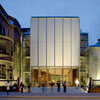
photo by Michel Denancé, provided by permission of the Morgan Library and Museum
J.P. Morgan Library Museum
J.P. Morgan Library and Museum Access
J.P. Morgan Library and Museum Building : architecture article by Joel Solkoff. 13 Jul 2013
Why did it take New York City so long to recognize that Renzo Piano is a good architect?
After decades of work throughout the world, after winning the highly respected Pritzker Award in 1998, it was not until five years later that Piano began work as a creative architect on a project in New York City. What is wrong with New York?
USA Architecture Design
Contemporary US Building Designs – recent architectural selection from e-architect below:
American Building Developments
Comments / photos for the Morgan Library and Museum Disability Access Design – Renzo Piano New York City Building Article page welcome

